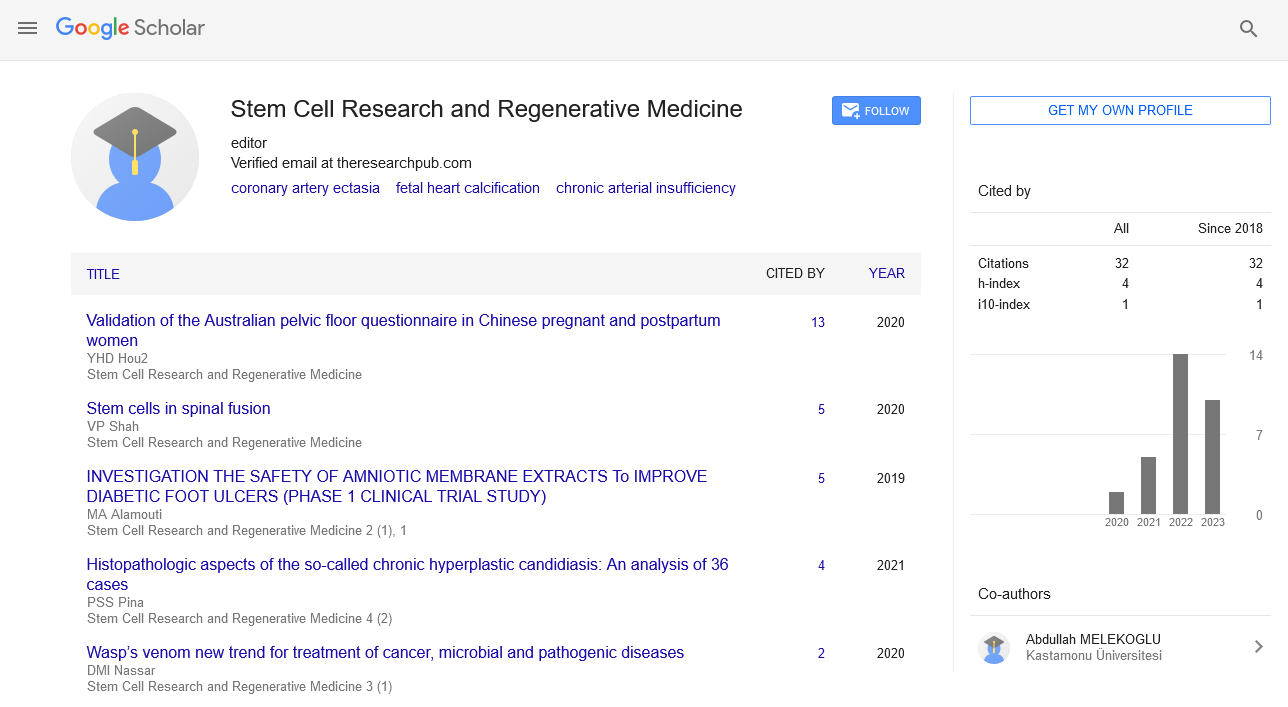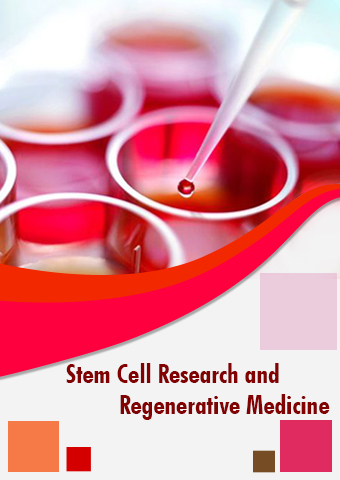Perspective - Stem Cell Research and Regenerative Medicine (2024) Volume 7, Issue 6
Bioinks and Biomaterials in Scaffold Creation: The Future of Tissue Engineering and Regenerative Medicine
- Corresponding Author:
- Thomas G H Diekwisch
Department of Regenerative Medicine, University of Goma, Goma, North Kivu, Congo
E-mail: diekwisch@gmail.com
Received: 02-Dec-2024, Manuscript No. SRRM-24-153860; Editor assigned: 04-Dec-2024, Pre QC No. SRRM-24-153860 (PQ); Reviewed: 18-Dec-2024, QC No. SRRM-24-153860; Revised: 23-Dec-2024, Manuscript No. SRRM-24-153860 (R); Published: 31-Dec-2024, DOI: 10.37532/SRRM.2024.7(6).275-277
Introduction
The development of bioinks and biomaterials for scaffold creation is revolutionizing the field of tissue engineering and regenerative medicine. These innovations aim to address the limitations of traditional approaches in repairing, replacing, or regenerating damaged tissues and organs. By creating structures that mimic the Extracellular Matrix (ECM) and provide a supportive environment for cell growth and differentiation, bioinks and biomaterials offer a promising pathway toward fabricating functional, patient-specific tissues and organs.
Description
Bioinks, a crucial component in bioprinting technology, are specially formulated materials that contain living cells and other biological components. They are used to print three-dimensional structures layer by layer, simulating the complex architecture of native tissues. The development of bioinks has been driven by the need for materials that are biocompatible, printable, and capable of supporting cell viability and function. An ideal bioink must have the appropriate viscosity for extrusion, crosslink rapidly to maintain the printed shape, and provide a suitable environment for cellular attachment, proliferation, and differentiation. Hydrogels, derived from natural sources like alginate, gelatin, hyaluronic acid, and synthetic materials such as Polyethylene Glycol (PEG), are among the most commonly used bioinks due to their high water content and similarity to the native ECM.
The choice of bioink has a significant impact on the properties of the final scaffold. Natural bioinks, such as collagen, fibrin, and decellularized ECM, provide a biologically relevant environment for cells, mimicking the native tissue’s composition and structure. However, these materials can have limitations in mechanical strength and printability. On the other hand, synthetic bioinks offer greater control over the material properties, such as stiffness, degradation rate, and porosity, but may lack the inherent bioactivity of natural materials. Blending natural and synthetic bioinks is a common strategy to combine the advantages of both types, achieving a balance between mechanical properties and biological function.
Biomaterials used in scaffold creation extend beyond bioinks, encompassing a diverse range of substances designed to support and guide tissue regeneration. Biomaterials can be classified into three main categories: natural, synthetic, and composite. Natural biomaterials, including collagen, silk, chitosan, and alginate, are derived from biological sources and are valued for their biocompatibility, bioactivity, and ability to interact with cells in a manner similar to native tissues. Synthetic biomaterials, such as Polylactic Acid (PLA), Polycaprolactone (PCL), and Poly(Lactic-Co-Glycolic Acid) (PLGA), offer greater control over mechanical and chemical properties, enabling the creation of scaffolds with tunable characteristics to match specific tissue requirements. Composite biomaterials combine natural and synthetic components, aiming to integrate the bioactivity of natural materials with the durability and stability of synthetic ones.
The development of advanced biomaterials has enabled the creation of scaffolds with specific properties tailored to the target tissue. For example, scaffolds intended for bone regeneration require materials with high mechanical strength and osteoconductive properties to support load-bearing and promote bone formation. In contrast, scaffolds for soft tissues like cartilage or cardiac muscle need to be flexible, elastic, and capable of integrating with the surrounding tissue without causing inflammation or rejection. Recent advances in material science have led to the emergence of smart biomaterials, which can respond to external stimuli, such as temperature, pH, or light, to promote cell growth, release therapeutic agents, or degrade when no longer needed.
One of the most exciting developments in the use of bioinks and biomaterials is the rise of bioprinting technology. Bioprinting enables the precise deposition of bioinks layer by layer to create complex, three-dimensional structures that closely mimic the architecture of native tissues. This level of precision allows for the fabrication of scaffolds with controlled porosity, microarchitecture, and spatial distribution of cells, growth factors, and other bioactive molecules. By controlling these parameters, researchers can influence cell behavior, including adhesion, migration, proliferation, and differentiation, to guide tissue formation. Bioprinting also allows for the incorporation of multiple cell types within a single scaffold, facilitating the creation of more complex tissues that better replicate the functional properties of native organs.
Bioprinted scaffolds have shown great promise in various fields, from bone and cartilage regeneration to skin grafts, cardiac patches, and neural tissue engineering. In bone regeneration, for instance, bioprinted scaffolds loaded with osteogenic factors have demonstrated the ability to promote bone formation and accelerate healing in critical-sized defects. In cartilage tissue engineering, hydrogels loaded with chondrocytes and growth factors have been used to create scaffolds that mimic the mechanical and biochemical properties of native cartilage. These advancements highlight the potential of bioprinted scaffolds to provide custom-tailored solutions for patients, reducing the need for donor tissues and minimizing the risk of immune rejection.
Despite the significant progress in the field, challenges remain in the development and clinical translation of bioinks and biomaterials. One of the primary challenges is achieving the appropriate mechanical strength and structural stability required for certain tissues, such as bone and load-bearing cartilage. Many bioinks, particularly those derived from natural sources, lack the mechanical properties needed to withstand physiological forces and may require additional reinforcement. Furthermore, ensuring the long-term viability and functionality of cells within bioprinted scaffolds is a critical concern. Cells must remain viable during the printing process, and the scaffold must support their proliferation and maturation into functional tissue over time. Controlling scaffold degradation is also essential, as the material must degrade at a rate that matches the formation of new tissue without causing inflammation or toxicity.
Another challenge lies in scaling up the production of bioinks and bioprinted tissues for clinical applications. The current bioprinting processes are often limited by the speed and resolution of the printing technology, making it difficult to produce large, complex tissues or organs in a timely and cost-effective manner. Additionally, regulatory challenges and the need for rigorous testing of bioprinted products add to the complexity of translating these innovations into clinical practice. The standardization of bioinks and biomaterials, ensuring consistency and reproducibility, is also crucial to gaining regulatory approval and widespread acceptance in the medical community.
The potential of bioinks and biomaterials goes beyond tissue engineering and extends into drug testing and disease modeling. Bioprinted tissues can serve as more accurate in vitro models of human biology, providing a valuable alternative to traditional cell cultures and animal models. These models allow researchers to study disease mechanisms, test drug efficacy and toxicity, and identify potential therapeutic targets in a more physiologically relevant environment. By using patient-specific cells, it is possible to create personalized disease models that reflect the genetic and phenotypic characteristics of individual patients, paving the way for precision medicine and personalized therapies.
Looking forward, the future of bioinks and biomaterials in scaffold creation is poised for exciting advancements. The integration of stem cells, including induced Pluripotent Stem Cells (iPSCs) and Mesenchymal Stem Cells (MSCs), with bioinks holds promise for creating scaffolds with enhanced regenerative potential. iPSCs, in particular, offer the possibility of generating patient-specific cells for autologous transplantation, reducing the risk of immune rejection. Advances in gene editing technologies, such as CRISPR-Cas9, could also play a role in enhancing the regenerative capacity of cells within bioprinted scaffolds by correcting genetic defects or engineering cells to express therapeutic factors.
Nanotechnology is another area that may significantly impact the development of bioinks and biomaterials. Incorporating nanoparticles into bioinks can provide additional functionalities, such as controlled drug release, enhanced mechanical properties, or improved cell attachment. Nanomaterials can also mimic the nanoscale features of the ECM, creating a more realistic microenvironment for cells and promoting tissue-specific differentiation. As the understanding of cell-material interactions deepens, the design of biomaterials will become increasingly sophisticated, leading to scaffolds that are more effective at guiding tissue regeneration and integrating with host tissues.
Conclusion
The use of bioinks and biomaterials in scaffold creation is transforming the landscape of tissue engineering and regenerative medicine. These innovations are paving the way for the development of functional, patient-specific tissues and organs, potentially addressing the shortage of donor organs and providing new treatments for a wide range of diseases and injuries. While challenges remain, the rapid advancements in material science, bioprinting technology, and stem cell biology are moving the field closer to realizing the full potential of bioinks and biomaterials. The journey from bench to bedside will require a collaborative effort between researchers, clinicians, engineers, and regulatory bodies, but the promise of creating functional tissues and organs that can heal and regenerate holds immense potential for the future of medicine. As the field continues to evolve, the dream of printing complex, fully functional organs may one day become a reality, changing the way we approach healthcare and improving the lives of millions worldwide.


